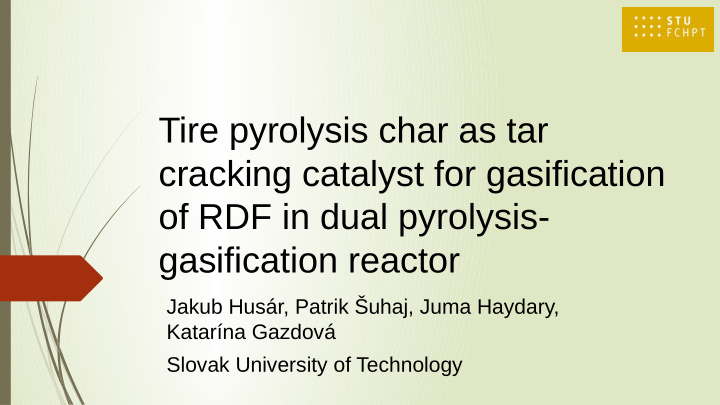



Tire pyrolysis char as tar cracking catalyst for gasification of RDF in dual pyrolysis- gasification reactor Jakub Husár, Patrik Šuhaj, Juma Haydary, Katarína Gazdová Slovak University of Technology
Presentation summary Introduction Preparation and properties of studied tire pyrolysis char catalyst Goals Tar cracking activity test RDF gasification experiments Conclusion
Pyrolysis Thermochemical process, no oxidizer Products Solid – char – solid fuel, catalyst support, adsorbent Liquid – tar, bio-oil – liquid fuel Gaseous – pyrolysis gas – gaseous fuel, hydrogen separation
Gasification Thermochemical process based on partial oxidation of the feed Gasifying agents: air, oxygen, steam, CO 2 Main product – synthesis gas Heat and electricity production Hydrogen separation Synthesis of organic compounds (methanol) Side products Ash – incombustible fraction of them feed, can contain unreacted carbon Tar – undesirable product, impurity in synthesis gas
Tar Complex mixture of condensable hydrocarbons and their derivates Causes fouling, corrosion and catalyst poisoning in downstream processing units Tar removal Physical means: condensation, absorption, filtration – expensive Chemical means: thermal decomposition, catalytic decomposition
RDF Refuse-derived fuel Made from MSW by removing incombustibles and bio- degradable waste Fraction Paper Foil Plastics Textile RDF RDF composition [wt. %] 63.17 15.78 19.1 1.94 100 Ultimate analysis [wt. % dry basis] C 35.0 76.5 66.4 50.3 47.8 H 5.0 12.8 9.16 6.4 7.05 N 0.05 0.1 0.94 3.3 0.29 S 0.08 0.12 0.35 0.33 0.14 O 39.4 1.78 9.42 31.3 27.6 Cl 0.07 0.09 3.53 1.8 0.08 Ash [wt. % dry basis] 20.4 8.69 10.2 6.6 17.0
Tyre pyrolysis char Suitable material for catalyst production (catalyst or catalyst support) High specific surface area (requires activation) High metal content (mostly Zn) Combustible (advantage and disadvantage at the same time) Can be impregnated with Ni, Fe and other catalytically active metals
Catalyst preparation procedure 1. Pelletizing of raw char into pellets with a diameter of 5 mm and length of 5 mm 2. Drying in oven at 105 °C for 6 h 3. Carbonization in CO 2 atmosphere at 800 °C for 4 h 4. Impregnation with Ni(NO 3 ) 2 solution – 2 wt. % Ni loading 5. Drying in oven at 105 °C for 6 hours 6. Heat treatment in N 2 atmosphere at 800 °C for 2 h S BET [m 2 /g] v pore d pore [cm 3 /g] [nm] Raw char 45.0 0.394 24.6 Carbonized char 72.4 0.328 16.9 Impregnated char 66.9 0.315 18.4 Finalized catalyst 88.4 0.328 16.3
Goals 1. To test the activity of the catalyst on model tar compound – toluene 2. To test the activity of the catalyst on real tar from RDF gasification 3. To evaluate the impact of air flow and gasifier temperature on total tar yield and hydrogen content in the product gas
Experiments with toluene - apparatus
Experiments with toluene – conditions Reactor temperature – 800 °C N 2 flow – 22.5 L/h CO 2 flow – 2.5 L/h Toluene feed – 3 mL/h – 2 vol. % in feed gas Catalyst mass – no catalyst or 10 g Experiment duration – 2 h
Experiments with toluene - results 10 g 10 g No catalyst carbonized finalized catalyst catalyst Toluene conversion [wt. %] 72.7 93.5 94.0 Liquid yield [wt. %] 70.7 50.8 42.1 Coke yield [wt. %] - 27.2 14.9 Gas yield [wt. %] 29.3 22.0 43.0 10 g 10 g No catalyst carbonized finalized catalyst catalyst Methane [vol. %] 0.6 0.4 0.5 Other hydrocarbons [vol. %] 0.05 0.01 0.01 CO 2 [vol. %] 8.6 10.6 6.9 H 2 [vol. %] 1.3 3.5 5.4 CO [vol. %] 0.8 3.9 7.1 N 2 [vol. %] 88.7 81.6 80.1
Dual pyrolysis-gasification reactor experiments - apparatus
Dual pyrolysis-gasification reactor experiments - conditions Pyrolysis reactor – 550 °C Gasification reactor – 700-900 °C N 2 flow – 15 L/h Air flow – 0-15 L/h Catalyst mass – none or 10 g of finalized catalyst RDF – 10 g Experiment duration – 1 h
Dual pyrolysis-gasification reactor experiments - results Tar - no catalyst Tar - 10 g of catalyst H2 - no catalyst H2 - 10 g of catalyst 60 30 50 25 Hydrogen content [vol. %] 40 20 Tar yield [mg] 30 15 20 10 10 5 0 0 0 2 4 6 8 10 12 14 16 0 2 4 6 8 10 12 14 16 Air flow [L/h] Air flow [L/h] Gasifier temperature – 800 °C
Dual pyrolysis-gasification reactor experiments - results Tar - 10 g of catalyst H2 - 10 g of catalyst 75 35 33 70 Hydrogen content [vol. %] 31 65 29 60 Tar yield [mg] 27 55 25 50 23 45 21 40 19 35 17 30 15 700 720 740 760 780 800 820 840 860 880 900 700 720 740 760 780 800 820 840 860 880 900 Gasifier temperature [°C] Gasifier temperature [°C] Air flow - 10 L/h
Conclusion Tire pyrolysis char is a suitable catalyst and catalyst support which promotes tar decomposition Nickel loading increases catalyst activity and decreases coke formation of the surface of the catalyst In experiments with RDF gasification, catalyst presence decreased total tar yield by up to 69 % Lowest tar yield was achieved at gasifier temperature of 750 °C and air flow of 7.5 L/h The highest H 2 production was achieved at 850 °C Gasifier operation temperature above activation temperature of the catalyst leads to removal of volatiles from the catalyst. Thus, tar is produced from the catalyst itself.
Recommend
More recommend